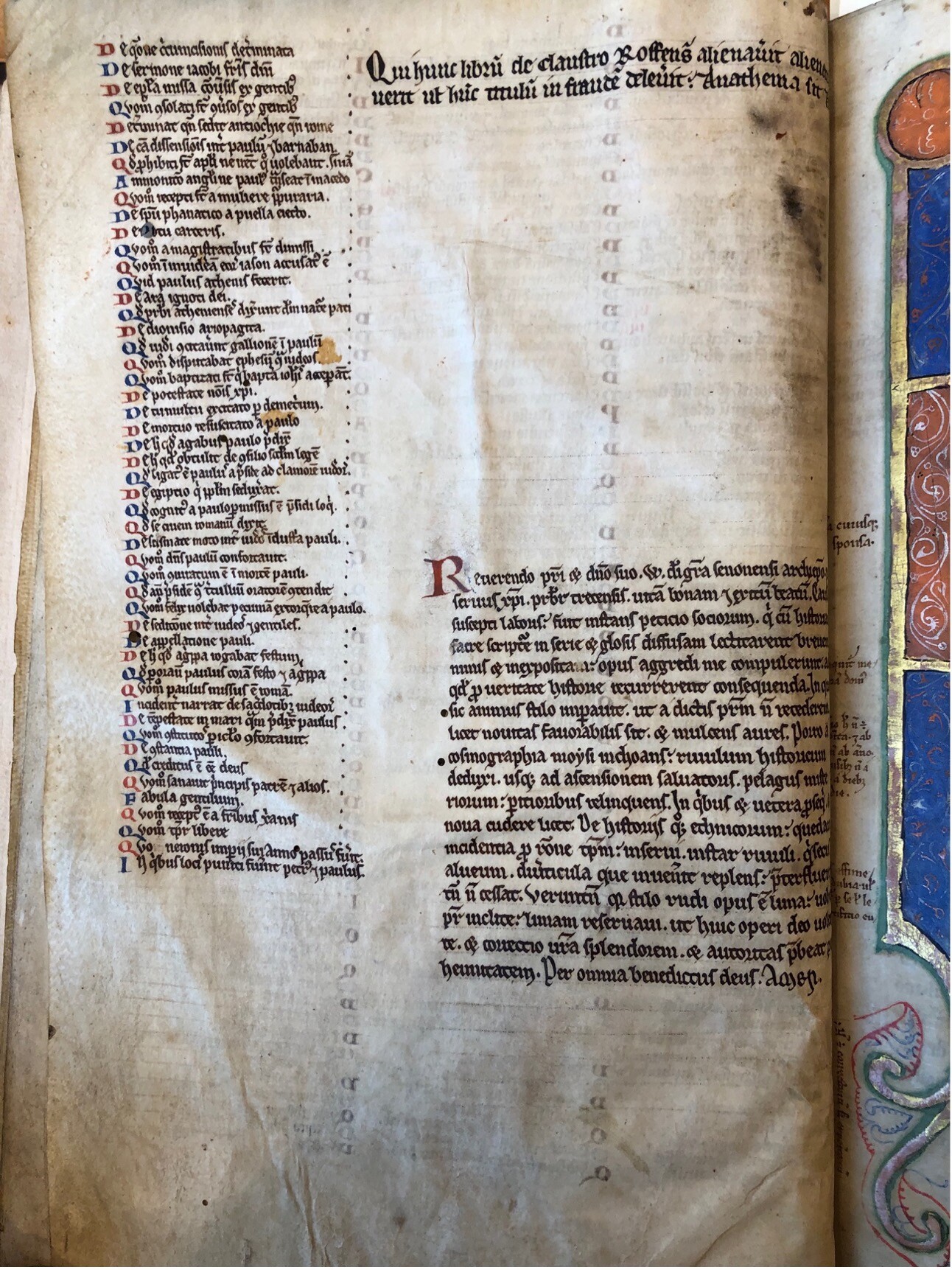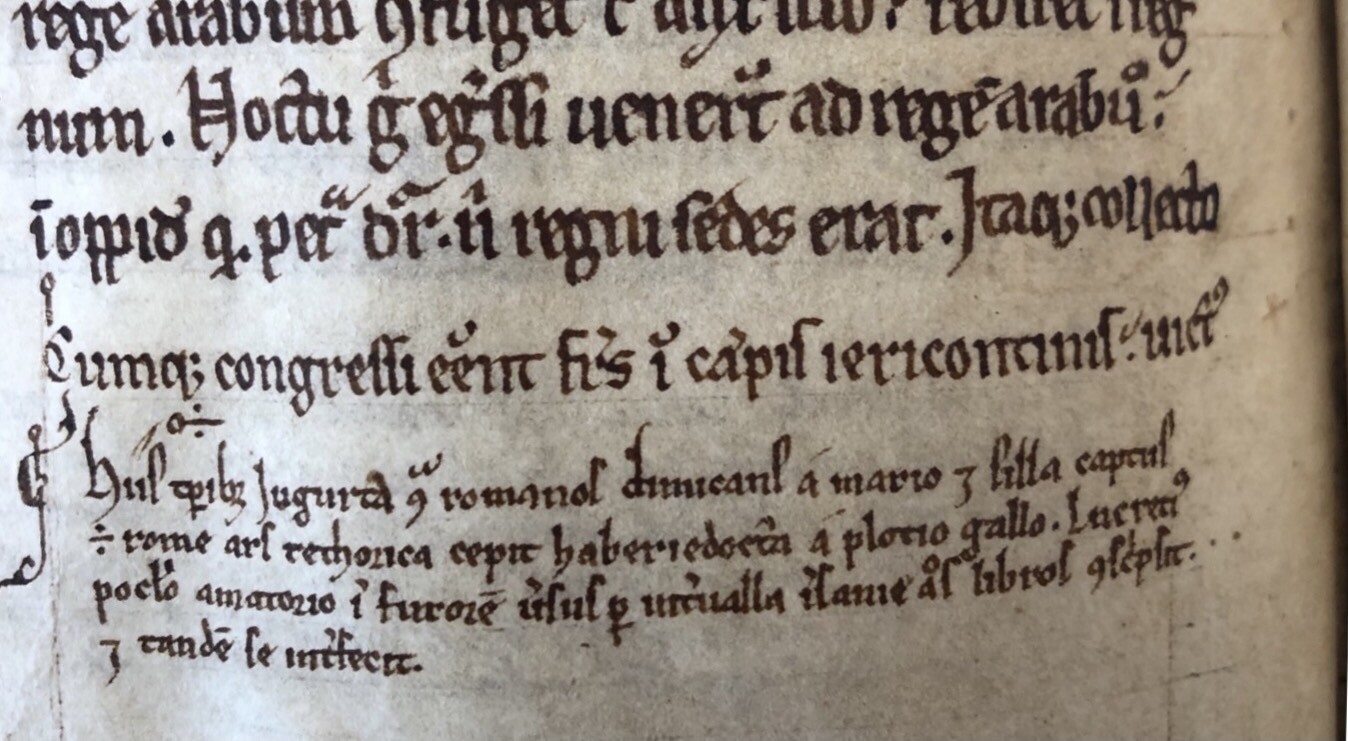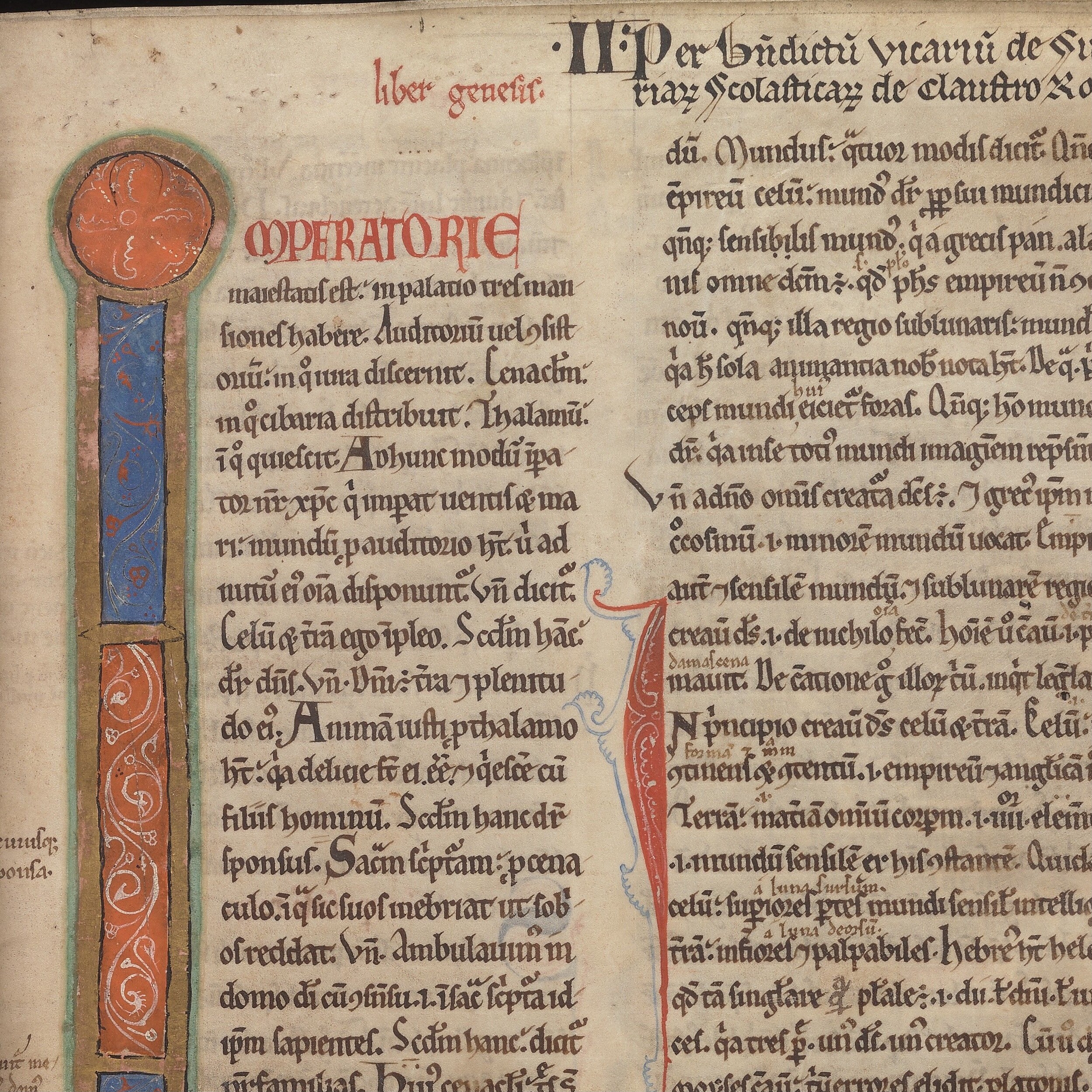Osborn fa38: An Early Copy of Petrus Comestor’s Historia scholastica
Petrus Comestor’s Historia scholastica, composed in Latin and completed in Paris in the 1170s, was one of the key texts for historical and scriptural education among schoolmen throughout the Middle Ages. It contained a universal history steeped in Biblical and classical references, and it eventually became a core part of the curriculum at the medieval universities in Paris, Oxford, and elsewhere in Europe. The text’s usefulness as a pedagogical tool for Biblical history meant that manuscript copies proliferated across Europe throughout the Middle Ages. One historian has estimated that more than 800 copies survive.

Beinecke Library, Osborn fa 38, fol. 1v. Depicted is an anathema inscription — a common tactic among medieval bookmakers to deter thieves. This one reads: “Qui hunc librum de claustro Roffensis alienaverit, alienatum celaverit, vel hunc titulum in fraudem deleverit: Anathema sit. Amen.” (“Whoever should remove this book from the cloister of Rochester, conceal it elsewhere, or deceitfully destroy this inscription: May there be a curse [upon them]. Amen.” )
The Beinecke is fortunate to possess an early copy of this important medieval text, produced in the priory of Rochester Cathedral in England around the end of the twelfth or beginning of the thirteenth century. Osborn fa38 is notable because this early copy of the Historia scholastica is replete with marginal notes with supplementary explanations, abundant references to a range of Christian and classical authors, and summaries of the text’s contents.
These marginalia, combined with information we can gather from surviving Rochester Cathedral library catalogues (Rochester Cathedral Library MS A.3.5 and British Library Royal 5 B XII), make Osborn fa38 an extraordinary witness to what the scholars at Rochester Cathedral were reading, how they made use of the information from their texts, and the ways books and ideas circulated throughout Europe in the Middle Ages.
The medieval marginalia range from contemporary hands written in a systematic, highly organized fashion (with ruled lines, rubricated flourishes and capitals, and steady, consistent script), to later fourteenth-century hands scrawled hastily and without any regular structure. There are also some much later annotations from the period after King Henry VIII seized the books and manuscripts from Rochester Cathedral during the dissolution of the English monasteries in the sixteenth century. In fact, a tantalizing note on fol. 236r even refers to “Henrycus dei gratia” (“Henry, by the grace of [King]”), a standard formula for European monarchs during and after the Middle Ages and possibly a reference to the king himself.

Beinecke Library, Osborn fa38, detail of fol. 236r. The pen the trials in the right column contain the words “Henrycus dei gratia” (“Henry by the Grace of God”). ‘Dei gratia’ was a common regnal formula with origins in the Middle Ages. In this case, the words may have been written during the reign of King Henry VIII, who seized this manuscript from Rochester Cathedral during the dissolution of the monasteries in the sixteenth century.
The earliest marginalia (dating generally to the period when the manuscript was written) mostly fit in three categories: short phrases that summarize a passage, explanatory notes that elucidate the main text, and corroborating notes that provide similar examples or discussions from other sources. Many of the notes reference authors ranging from Greek philosophers like Plato and Aristotle to later classical authors like Horace and Josephus to church fathers like Origen, Jerome, Augustine, and Bede. The notes contain little tie-marks that point to the part of the text being referenced.
Setting aside scriptural references, most of the marginalia cite patristic and Late Antique authors whose works are often used to elucidate theological matters. The authors who are most frequently cited by name are Jerome (twenty-three references), Augustine (twelve references), and Bede (nine references), and other authors in this group include Isidore of Seville, Origen, and Ambrose. The marginalia in the manuscript also bear witness to the ways that the members of the priory engaged with non-Christian classical texts. Josephus appears at least seventeen times, usually as a source of historical information found probably in The Jewish War and Antiquities of the Jews.

Beinecke Library, Osborn fa38, detail of fol. 150r. A marginal note citing information from Josephus about the river crossed by the ancient Persian king Artaxerxes. The full note reads: “In historiis gentilium est dicitur flumen intelligitur eufrates. / In historiis iudeorum jordanis.” (“In the Historiae Gentilium, it is said that the river is understood as the Euphrates. In the Historiae Iudeorum [Antiquities of the Jews], the Jordan [River].”)
An annotation on fol. 150r is typical of the ways Josephus is cited. Tied to a passage in the main text about “Artaxerses qui ochus dictus est” (“Artaxerxes, who is also called Ochus,” referring to Artaxerxes III of the Achaemenid period; r. 358–338 BC), the annotation explains that, when Artaxerxes III sent prefects to “all the regions across the river,” the river in question was, according to a work by Josephus, the Jordan River. Another annotation referring to Horace is noteworthy because this is one of the few instances, along with a brief mention of Lucretius, of a marginal note referring to an author whose works are not connected to Biblical topics.

Beinecke Library, Osborn fa38, detail of fol. 161v. The last sentence in this note in the lower margins of the folio contains an apocryphal anecdote about the Roman author Lucretius (c. 99–55 BCE) dying from suicide: “Lucretius poculo amatorio in furorem versus per intervalla insanie aliquos libros conscripsit et tandem se interfecit.” (“Lucretius, rendered into a frenzy by a love potion, wrote several books during a brief period of insanity and then killed himself.”) This spurious legend has no earlier source than Jerome, who recorded it in his translation of Eusebius’ Chronicon. See D.B. Gain (1969). Just above this mention of Lucretius is an explanatory note about Rome’s war with the Numidian king Jugurtha (r. 118–105 BCE) under the leadership of Gaius Marius (c. 157–86 BCE) and Lucius Cornelius Sulla (138–78 BCE) and a reference to the first-century BCE rhetorician Lucius Plotius Gallus.
This short discussion barely scratches the surface of the contents of the Osborn fa38. These hundreds upon hundreds of marginal annotations alone could stand further treatment. The notes contain many other scattered references to authors and texts not mentioned in the discussion above, including the Vita Clementis, Rabanus Maurus, the Homilies of St. Gregory, a Vita Alexandri, a Vita philosophi, and a Historia gentilium. There is much more insight to be gleaned from this treasure trove of intertextuality that can help us understand how people in the Middle Ages were sharing and utilizing knowledge from their reading, and how every inch of medieval manuscripts, even the messy scribbles in the margins, can hold important information about the past.
Shahrouz Khalifian
January 18, 2022
Selected Bibliography
CLARK, Mark J. The Making of the Historia scholastica, 1150–1200. Toronto: Pontifical Institute of Mediaeval Studies, 2015.
DAHAN, Gilbert, editor. Pierre le Mangeur ou Pierre de Troyes, Maître du XIIe siècle. Turnhout: Brepols, 2013.
English Benedictine Libraries: The Shorter Catalogues. Edited by R. Sharpe, J.P. Carley, R.M. Thomson, and A.G. Watson. Vol. 4 of the Corpus of British Medieval Library Catalogues. London: The British Library, 1996.
GAIN, D.B. “The Life and Death of Lucretius,” Latomus 28, 3 (July-September 1969): 545–553.
MOREY, James H. “Peter Comestor, Biblical Paraphrase, and the Medieval Popular Bible.” Speculum 68 (1993): 6–35.
RICHARDS, Mary P. Texts and Their Traditions in the Medieval Library of Rochester Cathedral Priory. Philadelphia: The American Philosophical Society, 1988.
SYLWAN, Agneta. “Petrus Comestor, Historia scholastica: Une nouvelle edition.” Sacris erudiri 39 (2000): 345–382.
“Historia scholastica, [1190s].” Osborn fa38. Yale University Library Catalog. Link.
